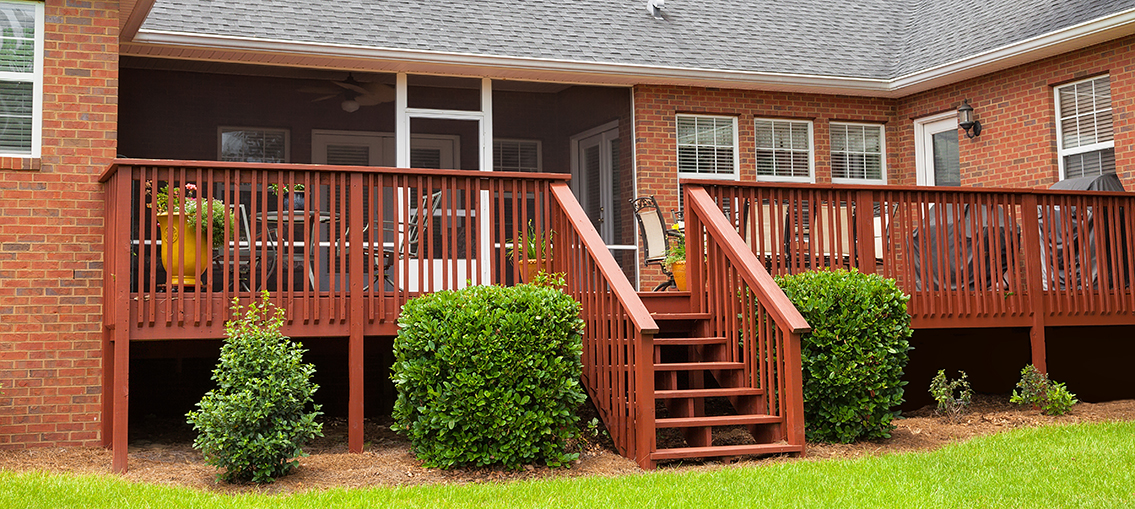Decks provide a fantastic setting to enjoy the outdoors and entertain friends and family. While decks offer a great place to unwind and enjoy the outdoors, you will want to make sure they are in top shape, so enjoyment doesn’t get cut short due to an accident. Collapses and failures of decks, porches, and balconies accounted for about 2,900 injuries between 2016 and 2019.
May is National Deck Month, marking the time of the year when more homeowners will be taking advantage of their own outdoor space. It is also a perfect time to assess your deck for any dangers and get ahead of any maintenance to enjoy your deck fully with peace of mind.
Here are some helpful maintenance tips to make sure your deck remains safe throughout the whole season:
1) Conduct a Visual Inspection of Your Deck at the Start of the Season
Each year at the start of spring, inspect the state of your deck. Look for any issues that may have developed due to usual wear and tear.
Assess the Wood
Check the wood throughout the entire deck to confirm it is in sound condition. Inspect all boards, railings, stairs, and ledger board (this connects the deck to the house itself.) Survey underneath the deck to evaluate the support posts and joists. Look for anything out of the ordinary; for example, wood that appears to be spongy or rotted suggests water damage decay. Keep an eye out for any significant cracking or small holes, possibly due to insects. Also, listen for any notable creaks or other strange noises heard during the inspection.
Flashing
Flashing is the deck component that directs water away from sensitive areas—often installed on the ledger that connects the house and the deck, keeping moisture and debris from collecting and damaging the connection between the structures. Check to ensure the flashing is securely held in place and look for any signs of water collecting, which may require replacement.
Fasteners
Nails, screws, and anchors in the ledger board are examples of fasteners you may encounter in your deck. Throughout the inspection, hammer in any loose nails and tighten any other fasteners that appear unsecured. If any fasteners are rusty or corroded, replace them to avoid further damage spreading into the surrounding wood.
Railings, Banisters, and Stairs
Check that all railings are correctly secured. Note any looseness or wobbling as they signify a risk of failure. If left unchecked, it could lead to injury or damage to the deck. The stairs should also be secure, with a sturdy railing present. Keep the stairs and surrounding areas clear of any décor, such as potted plants, to prevent the added risk of injury.
Calling In Backup
Hiring a professional home inspector or deck builder to conduct a comprehensive inspection of your deck is a helpful option. The average homeowner may not be able to detect all the signs of issues like water damage, insect infestation, wood rot, and separation of the house and deck ledger board. Some early warning signs may not be easily detected, especially to the untrained eye.
The average lifespan for a deck is 15 years, so plan to have your deck professionally inspected every five years to supplement your inspections. If your deck is closer to 30-40 years old, hiring a professional deck specialist or home inspector is advisable to conduct a complete evaluation. They will assess the deck’s condition and recommend any required repairs.
2) General Maintenance
Clean away any debris and residue that has built up over the fall and winter seasons, as they can promote the growth of mold and mildew, leading to rotted wood. Having a clean and clear deck allows for more secure footing and reduces slipping incidents. If the deck coating has worn away over the seasons, now is a great time to seal or stain your deck to improve the waterproofing. Trim any branches hanging over the deck to prevent them from falling and damaging the structure or catching on fire from any grills and fireplaces located around the area.
3) Grill and Fireplace Safety
Ensure safe placement and use of such appliances as grills and fireplaces. Generally, you will want to keep a two-foot buffer between any structures of the deck or home, including railings, siding, awning, and overhangs, to prevent fire and smoke damage. Place the grill on a nonflammable grill mat and keep any flammable materials safely away from any children that may be around.
4) Keeping Your Deck Well Lit
When the sun goes down, adequate lighting throughout your deck ensures greater visibility and safety. Make sure every area of the deck has dedicated lighting. There are numerous options to illuminate your deck. Confirm that all the UL, ETL, or IP ratings or the lighting products are outdoor weather and wet condition approved.
Final Thoughts
Getting your deck prepped and ready at the start of the season will allow you to enjoy your time outdoors. While taking care of the repairs and maintenance might not be your first choice when the weather gets nice, you’ll be happy you took care of it early to relax with peace of mind!



